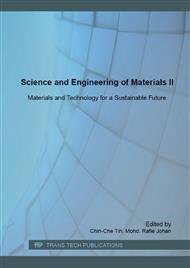p.265
p.270
p.275
p.281
p.286
p.291
p.295
p.300
p.307
The Effects of Graphene and Flame Retardants on Flammability and Mechanical Properties of Natural Fibre Reinforced Polymer Composites
Abstract:
The effects of incorporating three different types of flame retardant (FR) and two variants of graphene into 10 %wt palm EFB natural fibre (NF) filled epoxy composites were investigated in term of the flammability, thermal and mechanical properties through standard Bunsen burner experiment, bomb calorimetry, TGA and tensile tests. The types of FR employed include zinc borate (ZB), ammonium polyphosphate (APP) and alumina trihydrate (ATH) while a lab synthesised and a commercial form of graphene were used in the current work. Compared to the neat NF filled epoxy composite, specimens loaded with 15 %wt of either ZB or APP demonstrated a drip-free condition as observed from the Bunsen burner tests, which could be attributed to the strong char forming characteristic of the compositions. In specimens containing 15 %wt of either ZB or ATH, results from Bomb calorimetry revealed that these specific formulations produced the lowest mean gross heat release amongst others, suggesting better resistant to flame. Relative to the graphene incorporated composites, the post TGA measured mass residue was observed to be greater in FR rich formulations, suggesting that FR additives capable of yielding a much superior flame retardancy compared to graphene. While a slight increases in Young’s modulus was recorded in composites loaded with FR, such formulations produced several main drawbacks whereby reduction in ultimate tensile strength and elongation to break were being measured in large proportion of the specimens.
Info:
Periodical:
Pages:
286-290
Citation:
Online since:
July 2016
Authors:
Keywords:
Price:
Сopyright:
© 2016 Trans Tech Publications Ltd. All Rights Reserved
Share:
Citation:


